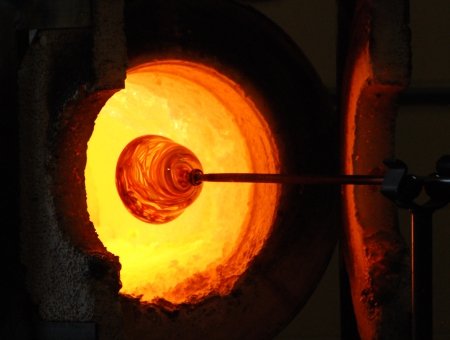I recently had the pleasure of hearing Jim Mckelvey – well known philanthropist, celebrated artist, accomplished author and, oh yeah… co-founder of Square – speak at a conference where he addressed the concept of timing with a particularly poignant analogy. As a passionate glass artist, Jim studied for a period under Lino Tagliapietra: the undisputed master of the craft. After a short while into his mini apprenticeship, Jim worked up the courage to ask the guru how to put a foot on a vase – one of the first things taught to beginners and a process Jim had done a thousand times. Nevertheless, Jim was irritated that he still hadn’t quite perfected the process. In response to this question, Tagliapietra told Jim: “demonstrate to me how you always do it”, and Jim began as instructed. Except this time, as he pulled the two pieces away from the heat source and drew them closer to each other, Tagliapietra interjected: “wait!” The glow of each piece dulled ever so slightly as they cooled. Then two seconds later: “now!” Jim did as he was told and connected the foot to the vase at that exact moment. Low and behold, the two pieces joined in a perfect union.
From a mechanical standpoint, Jim had been doing it perfectly all along. He just hadn’t fully appreciated the element of timing. In this case, a deliberate recognition of two seconds made the difference between a run of the mill piece and a masterful work of art.
So often we as entrepreneurs and investors focus solely on the ‘how’, as in: How will we build this product? How will we capture market share? How will we form this team? And then we then plot out the tactical execution in painstaking detail.
But as Jim’s story so aptly captures, there is another critical factor that should be carefully considered: the ‘when’. As in, when is the right time to do this? Unfortunately, like Jim and his glass, we all have a natural inclination to overweight the science of how and underappreciate the art of when.
Take as an example one critical decision point that every young company must face: When is the right time to push down the throttle? Getting this right or wrong can be the difference between success or failure. In fact, it’s so vital that we’ve made it a central part of our investment thesis.
Real world application: The right time to push down the throttle
When is my early stage software company ready to raise our first institutional round of capital (usually Series A) and start aggressively expanding the team? Typically, the impulse answer is: “as soon as we can”. This may be the most common pitfall that we see in early stage companies. It’s only natural to think: “If we achieved [insert *early* indicator of traction] with limited resources, imagine what we could do if we had more!” Yes, more capital can make life easier in the short term, but you should carefully consider whether the operations, processes and metrics are mature enough to predict – within a reasonable degree of error – the output from each new dollar in. Taking too much money too early can have severe consequences, particularly for the founder. Here are a few signs that it’s the right time to step on the gas (note: we recognize reality is always messier, but these are good checkboxes to strive toward):
- Product-market fit firmly established: Simply put, this means you’ve firmly established (i) what you are selling (you have an iterated and hardened product), (ii) who you are selling to (you’ve pin pointed your target market) and (iii) you have some track record of doing it (you have acquired multiple paying customers in your target market and worked through pricing issues). Most Series A investors will want to see a flow of happy, paying customers outside the founders’ direct network (exact number is more art than science and varies based on type of business). Customer engagement metrics are also critical to this: you should be able to show empirically that users are extracting meaningful value out of your solution. Compelling case studies demonstrating customer ROI should complement these usage stats.
- Sales process hardened and humming: You have implemented a system that efficiently identifies prospects and pulls them through the pipeline stages in a somewhat predictable fashion. Next, consider whether your regime is scalable. Ideally, there are enough data points to demonstrate that sales growth is aligned with sales staff growth, suggesting that the sales apparatus is primed for more resources. As a best practice, your pipeline should be structured so that the stages are clearly defined by measurable actions taken by the customer. This is particularly useful for lower volume enterprise sellers that may not have a plethora of closed deals but feel they have reached a predictable sales process as this discipline lends credibility to the movement within your funnel. For more details, see our prior post: Pipeline or Pipedream.
- Unit economics are reliable: You have enough data points to have a handle on your average price, churn, cost to acquire and cost to service a customer. In some cases, there is no churn to date so a figure must be estimated based on current levels of product usage and feedback – this is a good problem to have. See The Basics of Forecast Modeling for Early Tech Co’s for more details on how to think through the key factors in unit economics.
- Few / no glaring holes in exec management: One of the biggest risk factors in any business (especially early stage businesses) is assembling a balanced and capable leadership team. If you know that your organization is heavily weighted on the technical side, for example, identify a strong operational person, get him/her intimately familiar with the business and initiate discussions about what it would look like if he/she officially came on board. Even if that person doesn’t join immediately in a full-time capacity, identifying and establishing a rapport with a professional that helps fill a hole in your leadership team before your first significant capital raise will pay dividends.
Timing may appear to be an obvious factor to consider when it comes to scaling up your operation and increasing your burn, but it’s not quite so easy when you are in the fog of war. Incorporating the factors above into your decision will help you understand when the timing is right. As Lino demonstrated to Jim, sometimes pausing a bit to let a process harden before putting the foot down can make a world of difference.

